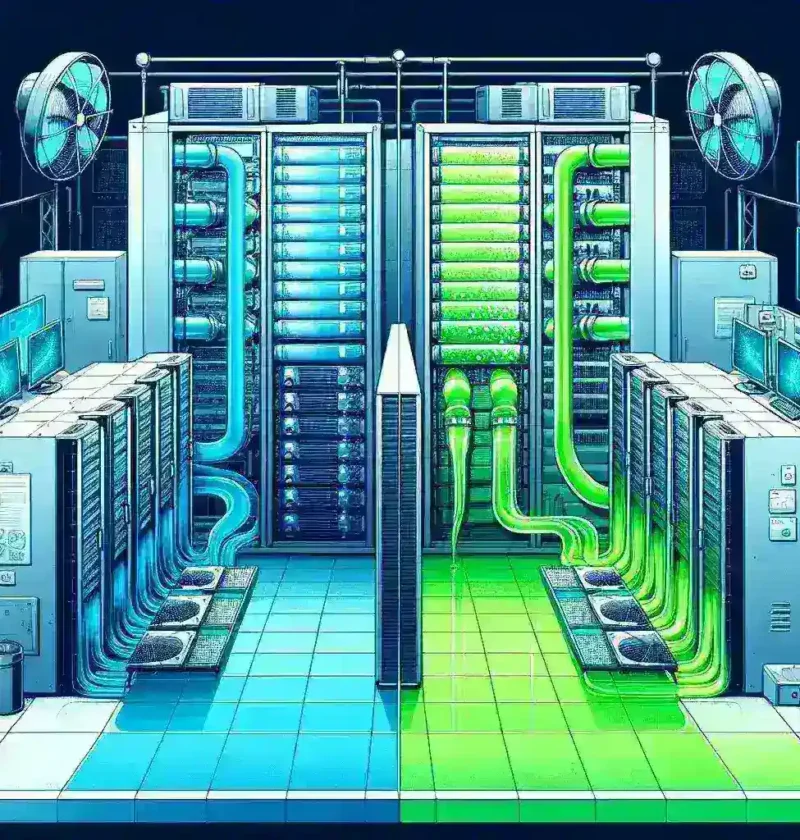Introduction
As technology continues to evolve, the demands on data centers have become increasingly complex. The rapid expansion of cloud computing, the Internet of Things (IoT), and big data analytics have led to a surge in the need for powerful and efficient data processing capabilities. To meet these demands, many data centers are making a significant transition from traditional air cooling systems to innovative liquid cooling solutions. This article explores the reasons behind this shift, the benefits and challenges of liquid cooling, and what the future holds for data center cooling technologies.
The Limitations of Air Cooling
Air cooling has long been the go-to solution for data centers, primarily due to its lower initial cost and widespread familiarity. However, as server densities increase and processing power demands rise, air cooling systems are facing several limitations:
- Inefficiency: Air cooling systems often struggle to effectively dissipate heat generated by high-density server racks, leading to hotspots and suboptimal cooling performance.
- Energy Consumption: The reliance on large air conditioning units to cool data centers leads to increased energy consumption, contributing to higher operational costs and a larger carbon footprint.
- Space Constraints: In densely packed environments, air cooling can require significant space for airflow, limiting the number of servers that can be installed.
Liquid Cooling: A New Era
Liquid cooling, which involves using water or other cooling liquids to absorb and dissipate heat, presents a compelling alternative to traditional air cooling methods. Here’s why data centers are increasingly turning to liquid cooling:
1. Enhanced Cooling Efficiency
Liquid cooling systems utilize the superior heat transfer capabilities of liquids compared to air. This allows for more effective heat removal, reducing the risk of overheating and ensuring optimal performance of servers. With liquid cooling, data centers can achieve greater thermal efficiency and maintain consistent operating temperatures.
2. Reduced Energy Consumption
By improving cooling efficiency, liquid cooling systems can significantly lower energy consumption. According to a report by data center experts, liquid cooling can reduce cooling energy usage by up to 50%, translating to lower operational costs and a smaller environmental impact.
3. Increased Server Density
Liquid cooling allows for higher server densities, enabling data centers to maximize their physical space. With the ability to handle more heat, data centers can install additional servers without the risk of overheating, thereby increasing overall capacity and processing power.
4. Future-Proofing Data Centers
As technology continues to advance, the demand for processing power will only increase. Liquid cooling systems are designed to accommodate future innovations, making them an investment that can adapt to evolving needs.
Types of Liquid Cooling Solutions
There are several types of liquid cooling solutions available for data centers, each with its own unique advantages:
- Direct-to-Chip Cooling: This method involves delivering coolant directly to the chips, enabling precise temperature control and efficient heat removal.
- Immersion Cooling: In this approach, servers are submerged in a non-conductive liquid that absorbs heat. This method can significantly reduce energy costs and cooling requirements.
- Rear Door Heat Exchangers: These units are mounted on the back of server racks and use liquid cooling to absorb heat as it is expelled, making them an effective retrofitting option for existing data centers.
Challenges of Liquid Cooling
While liquid cooling offers numerous benefits, it is not without its challenges:
- Initial Costs: The upfront investment for liquid cooling systems can be higher than traditional air cooling solutions, which may deter some data centers from making the switch.
- Maintenance and Management: Liquid cooling systems require careful management to prevent leaks and ensure system integrity. Data center staff must be trained to handle these systems effectively.
Future Predictions for Data Center Cooling
As the demand for data processing continues to grow, the transition to liquid cooling seems inevitable. Analysts predict that by 2025, over 30% of data centers will have adopted liquid cooling technologies. Innovations in materials and design will likely lead to further improvements in efficiency and cost-effectiveness.
Conclusion
The transition from air to liquid cooling in data centers is driven by the need for greater efficiency, lower energy consumption, and the ability to accommodate rising server densities. While there are challenges to overcome, the long-term benefits of liquid cooling make it a worthy investment for the future of data processing. As technology continues to advance, liquid cooling is poised to become the standard in data center design, ensuring that organizations can meet the demands of an increasingly digital world.

